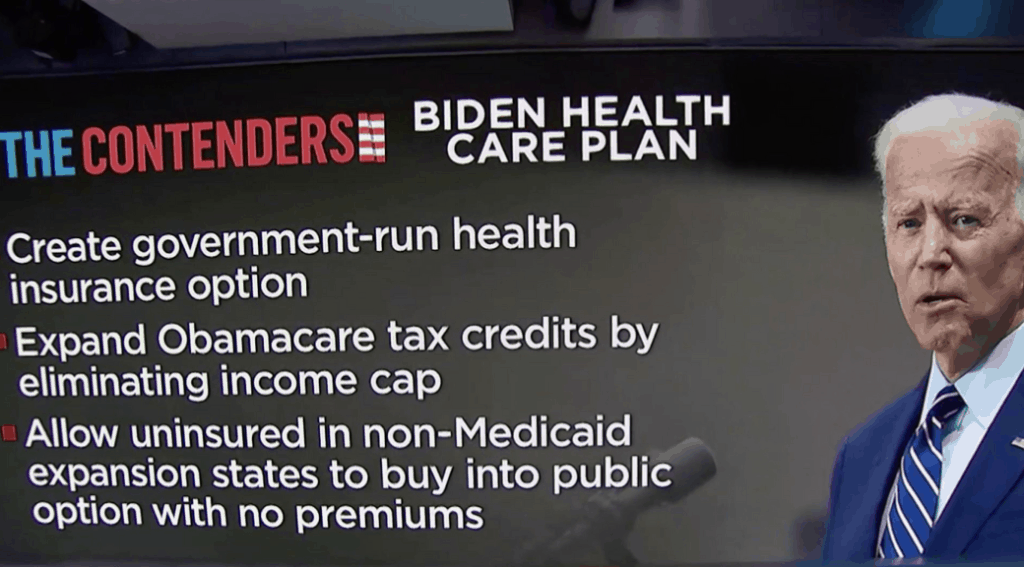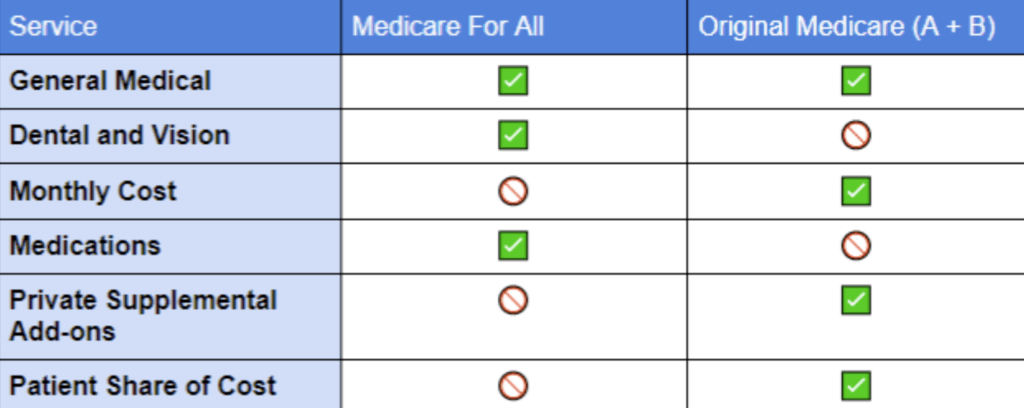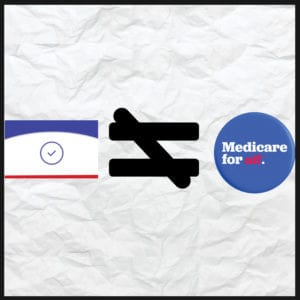Written by Robert Loyd
For us the topic of Medicare for all has been the most interesting political speaking point. Not for its pros or cons, it’s controversies, or anything like that, but for its lack of any relation to the Medicare program. Here we are going to discuss what Medicare For All actually is as discussed and what, if any, relation it has to the federal Medicare program.
What is it?
Medicare For All is the Democratic health care program that has been popularized by Senator Bernie Sanders and adopted by others such as Elizabeth Warren, Alexandria Ocasio-Cortez, and Bill de Blasio. The goal of the program is to make the health insurance system a single-payer system. This means the federal government will be the only source of health insurance available (hence only a single entity paying for all health costs). In turn, this program would seek to eliminate all private insurance options. Already this is very different from the current Medicare system, but more on that later.
There have been other Democratic politicians who have pushed for some variants of this program. I don’t want to get bogged down in all of these too much because how Medicare For All compares to the current Medicare program will highlight the pros and cons of these plans as well. I do, however, want to introduce you to them as a means to add clarity to what you may hear in these discussions.
Expand Medicare?
There has been talk about expanding our current Medicare system. This has been pushed in a variety of ways from allowing all Americans access to the current Medicare system, lowering the Medicare age to 50 instead of 65, to modifying the current Affordable Care Act (Obamacare) to be more like Medicare. The problem with this option is most every proponent for it still continues to use the Medicare For All slogan, due to its popularity and recognition. Presidential candidates like Cory Booker, Kirsten Gillibrand, and Kamala Harris all fall into this category.
A Public Option
To have a public option is nothing more than to say the government will offer its own health insurance plan. All private insurance will stay the same or get different regulations (often to make the public option more competitive). Essentially the government joins the health insurance industry as a competitor. The confusion here is Medicare is often used as an example of what a public option might look like and language like Medicare available to all. Obviously it’s close to Medicare For All. Presidential candidates in this camp include Joe Biden, Pete Buttigieg, Amy Klobuchar, and Mike Bloomberg.

Medicare For All vs. Original Medicare
Let’s take a glance to compare these two side by side on a chart. For the Medicare side we will be considering as if someone had both Medicare Parts A and B.

So this chart illustrates that the only thing the two programs have in common is that they cover general medical like doctors, hospital, imaging, labs, ect. This is expected of most any health insurance plan. Every other aspect of them is different.
Surprise!
There are a few misconceptions about the Medicare program. Many assume that it’s free and that the cost sharing will be similar to what they had while working. This is not at all the case. For most, you will pay 20% for all doctors visits and some tests. If you are hospitalized you will be responsible for a $1408.00 deductible. Top it off with the fact that most will pay $144.50 a month to get that coverage for doctors and tests (Part B). The only exceptions are those on Medi-Cal (Medi-Cal will pay for this cost) and those who generally make more than 80k a year after retirement (who will pay a higher premium based on how high their income is).
Now when it comes to covering things like dental, vision and medications, many are surprised to find out that Medicare does not cover these services. In all of these cases you will have to purchase some sort of private insurance whether it be a drug plan, Medicare Advantage plan, dental plan, ect to get coverage. The best way to think about the Medicare program is that it operates as a base level of coverage with the option to supplement it with private insurance for more coverage.
Why The Name?
Since it has little to nothing to do with Medicare we were wondering what the name was all about. After some research it seems the thought is one that’s been playing around the political field for a while but not much outside that. Historically there have been individuals pushing to expand the Medicare program to all Americans. More recently the program has been seen as expanding both the Medicaid and Medicare program for all (more on that soon). It’s been mentioned that Americans recognize the Medicare program as a successful government health care program. Hence the name Medicare for all would be able to project the confidence of what a government health plan could look like to the public. There are some problems with this.

Medicare hasn’t been considered the best run program within the government. In response to the Medicare for all push with Bernie Sanders the Administrator (essentially the CEO) of the Centers for Medicare and Medicaid Services (CMS, the organization that runs Medicare and Medi-Cal), Seema Verma, has come out and said that the Medicare program is not profitable and efficient in its current form. Hence, expanding the program would also expand its shortcomings and create budget and logistic problems for the country.
Hopefully this article has made you a more informed voter and given you a better perspective of the current healthcare system. Healthcare will continue to be a hot topic in the elections and political for the foreseeable future. Medicare will likely be around for quite a while. If you have any questions on Medicare options or the system in general, feel free to contact us.

 BREAKING BAD: Our Bad and Breaking Infrastructure, and What To Do About It
BREAKING BAD: Our Bad and Breaking Infrastructure, and What To Do About It